Where: This is the Royal Navy's dry dock, part of their dockyard in Hong Kong. The dry dock still exists, but it is now hidden out of sight.
The Royal Naval Dockyard closed in the late 1950s, then the dry dock was filled in with rubble during 1960. Since then it hasn't been disturbed though, instead it lies underneath the strip of sports pitches that runs north-south down the centre of the PLA's Central Barracks. I wonder if the exercising soldiers know what's beneath their feet?
Who: There are plenty of people in this photo, but not sailors as far as I can see, more likely the local men who worked in the dockyard.
We've caught them at a tense moment in the life of a dry dock. Look at the stepped side of the dock on the right, and note how the steps get wetter the lower they are. It's a sign that the dock is currently being pumped dry.
A dry dock is used when the parts of a vessel that are usually under water need to be repaired. The vessel sails into the dry dock, the dry dock's watertight gate is closed, and the seawater is pumped out to reveal the problem part. The riskiest time is while the water level is dropping - the men who are running the dry dock must take great care to support each vessel correctly, so that it doesn't fall over on its side.
Before the three vessels in this photo entered the dry dock, the workers would have laid three lines of blocks on the base of the dock, one for each of the vessels to rest on. Then as the water is pumped out and the vessels drop lower, they'd have made sure each vessel was correctly centred over its line of blocks.
Once the ship starts to settle on the blocks, attention turns to the large wooden beams that will keep the vessel from tipping over. In this photo, the ship is supported by two lines of beams along either side. For the two submarines, there are beams along each wall, and a third line of beams in the centre. It looks as though most of the beams are already in position, with just one last central beam being manhandled into place.
Finally, gangplanks are lowered into place to make it easier for the sailors and workers to get on and off the vessels. I count four gangplanks in all, three for the submarines, and a fourth being lowered into place by the big crane for access to the ship.
What: There are a couple of cranes visible, a smaller one on the left and that big one on the right. The smaller crane wouldn't be able to reach out very far, so I think its job was to lower material down to workers at the bottom of the dock.
The large crane can extend out to the centre of the dock, and can also handle much heavier loads. Examples of what it might be moving can be seen on the ground in the background. There look to be gun barrels on the left, and propellers on the right, both items that would need replacing from time to time.
We can see that the big crane moved on rails, and I've seen photos that show it could operate from either side of the dock. Other things I'm so so sure about though, and would welcome any knowledgeable reader's feedback:
- Could it move by itself, or was it pushed / pulled into place by a separate vehicle?
- How was the crane's lifting mechanism powered? I don't see any clouds of smoke coming from it.
- When did it arrive? It doesn't appear on early photos of the dry dock.
When: We've seen boat "H31" before.
In the conversation about that photo, it was identified as HMS Sterling, part of the 8th Destroyer Flotilla that was here from 1927 til 1931. The current photo has the word "Sterling" just faintly visible on the ship's stern:
Unfortunately the submarines don't have any identification I can see, but we've seen submarines in Hong Kong, e.g. this 1926 photo of HMS Titania and the local submarine flotilla:
A closeup shows the letter "L" on their conning towers, so they were all L-class submarines.
However, it also shows that the L-class submarine's conning tower was wider at the top than the bottom - it steps out about halfway up the tower. The submarines in the dry dock are a different design as their conning towers are straight-sided.
In late 1929, the Titania and her L-class submarines sailed back to Britain. In their place came HMS Medway and the newer O-class submarines. I can't find a photo showing an O-class submarine from exactly this angle, but the views I saw are a close enough match to say that's what was in the dry dock on this day.
So, the current photo was taken sometime between the arrival of the O-class submarines and the departure of the 8th Destroyer Flotilla, i.e. 1929-1931. At which point I thought it was a bit strange that I didn't have a scan of the back of this photo on my computer. Digging out the original photo, I found this note on the back:
'Odin' class
Hong Kong, Jan 1931
R/h boat: Osiris
Note to self - always scan both sides of the photo!
This is a photo I've been cleaning up, getting it ready to use in the new Volume 3 of the Gwulo books that I'm working on. If you spot any mistakes above, or you can add any information about the scene, please let us know in the comments below. I'd also be very interested to see any other photos of the dry dock you can share with us.
Trivia: On this occasion, after the dry dock's watertight gate was closed another of the Navy's ships moved in and moored next to it, overlooking the dry dock. A sailor on that ship had a camera and took a photo of the view, and that's how we get to see this scene.
Gwulo photo ID: ED012
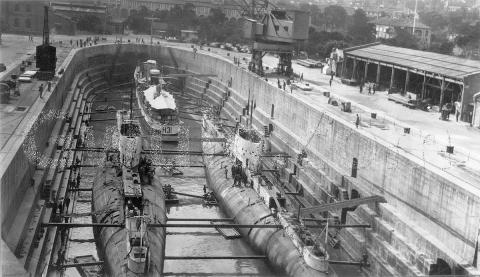
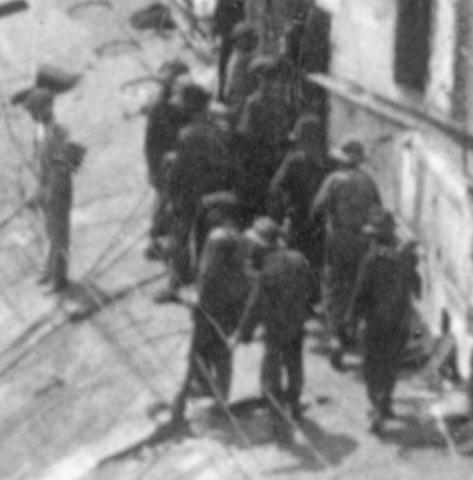
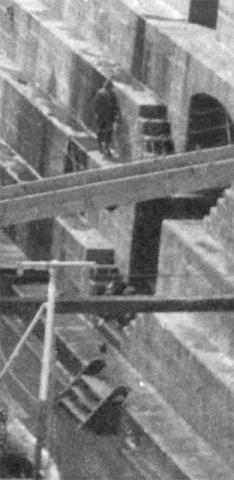
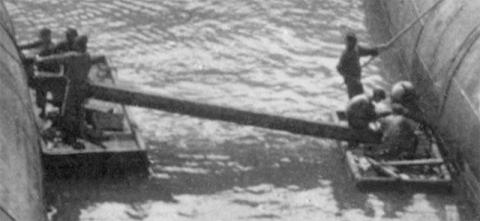
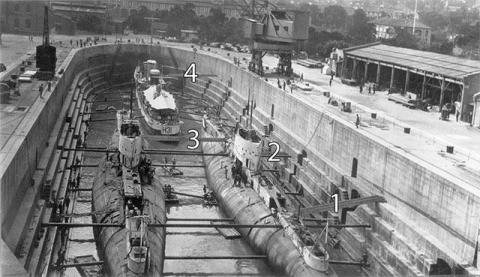

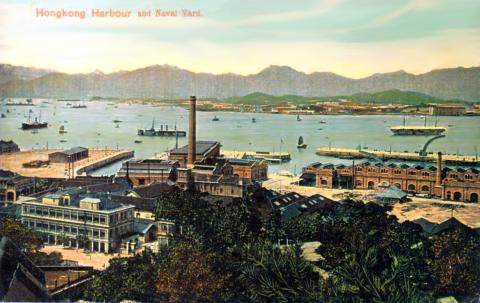

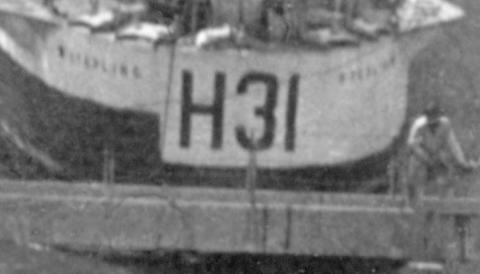
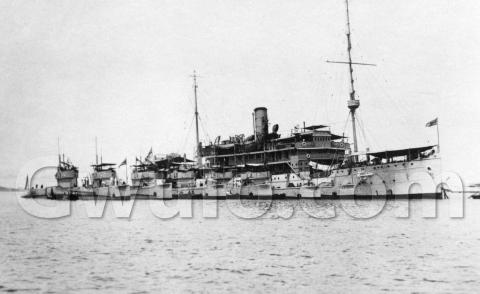
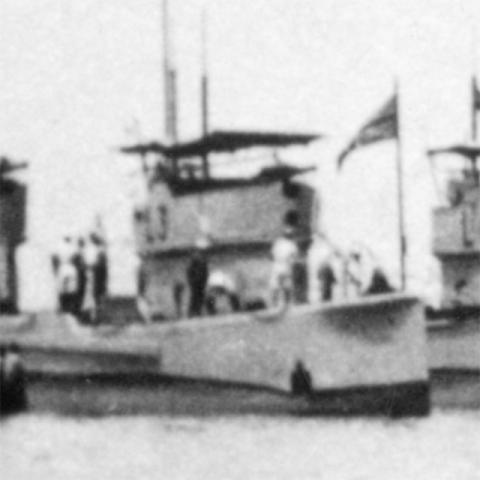
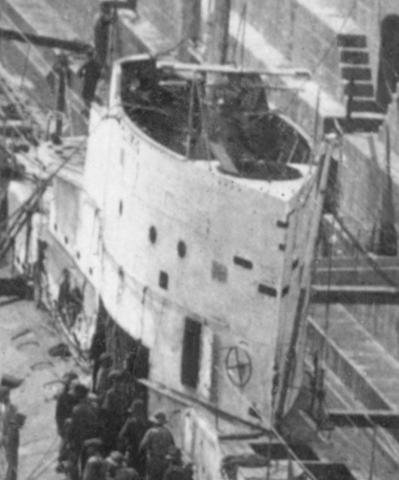
Comments
The dry dock
Just some minor wrinkles (old seagoing term for picky details, as in the navigator's vade mecum Lecky's wrinkles (in practical navigation))
Dry docks are pumped out (as you properly put it a bit lower down), not drained (they'd have to be above sea level for a drain to work). The 'water tight gate' is known as a 'caisson' usually pronounced, with a wild irrationality only British navalese seems to manage, 'cassoon' though occasionally (but not by 'old navy'!) 'kayson'. The local blokes attending to the 'beams', which are properly called 'shores', were colloquially known as 'dockyard mateys' or just 'mateys'. The 'gang planks' are called 'brows' usually in the singular with a more specific qualifier, 'port forward brow', 'quarterdeck brow', etc. (from the Old Norse 'bru' meaning a bridge) and occasionally (though not in the RN) gangways.
The shores that were being placed last, like the one you show being hauled into place, had to go in last because they were not supposed to take a lot of strain, since their ends are between the thin walls of the outside ballast tanks, which don't have much structural strength. All the ships would have had their sides marked up to make sure that shores were placed symmetrically on each side and, on the ship, up against a frame and not against unsupported plating.
The ship moored on the West Wall (that had two arms, west and east, either side of the dock entrance) from which the photo was taken was HMS Cumberland, which had arrived in HK on 12th March, 1928. She was back in UK for a refit in 1929-30, getting back to HK in April 1930. The Cumberland, back from a visit to north China (where she'd been pranged by the Butterfield and Swire steamer Poyang on 28th December (damaging the bow)) was on the West Wall from 28th Jan to 23rd Feb. She left for sea for an exercise on 24th Feb. The West Wall was c.750' long and a County Class cruiser 630' loa, so she covered the lot. Supposing she was berthed bows west (which seems to have been most usual), the part of the ship opposite the dock gate (and slightly left of centre), would probably have been the platform at the base of the port crane beside the aft funnel.
The big crane was a 30 ton electric travelling jib crane (i.e. driven by electric motors) built as order No. 4404 (drawing no. 1156) by Cowans, Sheldon & Co. of Carlisle in 1924 (drawings are held at the Cumbria Council archives). Cowans Sheldon built most of the HK naval dockyard cranes, including the Fairbairn steam cranes (the chaps that look like a quarter of a circle) that were the first installed in 1905. The company was taken over in 1961 and by 1987 only a design office remained in Carlisle. As Grace's Guide puts it, "The giant sheds were demolished and beefburgers are now fried where once some of the world's greatest cranes were made." (See also https://www.tulliehouse.co.uk/collections/cowans-sheldon-and-co-cranema…)
In 1926, two years after the crane for Hong Kong had been built, Cowans, Sheldon built the largest floating crane ever built at that time. The 150 ton lift monster, for the dockyard in Nagasaki, was used to build the warships that were to give so much trouble fifteen years later. Oh, the wonderful joys of the free market.
A larger, 50 ton lift clone of the HK yard crane was installed at the Sturrock graving dock in Cape Town during WW2. It is still there and really keen Meccano buffs can build a model (https://runnymedemeccanoguild.org.uk/gallery/sections/members,michael-a…)
Worth noting that the Odin class boats had a completely differently shaped bow to the 'L' class, the latter's being like that of a surface ship (flared) and the former's sloping down towards the water - not that that's easy to spot and made very much more difficult by the placing of the anti-piracy 'Gwulo' watermark. (The National Maritime Museum in Greenwich has the original starboard elevation and general arrangement plan drawings of the Osiris.) The two boats in the pic are the same class and conform to the plans of the Odin class - what I can see of the bow fits the specs.
The SCMP for Feb 17, 1931 answers the question of the second submarine's identity, noting that in dry dock that day were HMS/Ms Oswald and Osiris with HMS Sterling. The previous day the Sterling had not been docked. The two submarines were evidently in for a major overhaul (you can see the aft topedo tubes seem to have been removed on both) and had gone into dock between 15th Jan (when they went into dry dock with HMS Cornflower). The Cornflower undocked on 28th Jan and the Sterling dry docked on 17th Feb. Sterling came out of dock on 5th March and was promptly replaced by HMS Bridgewater. The Bridgewater and the S/Ms finally undocked between 14th & 18th March, the latter after two months on the blocks but, given the shuffling around, never having any major work done that prevented them from floating when changes were made as between the Cornflower, Sterling and Bridgewater. Obviously the dockyard team was pretty slick at flooding up, shifting vessels around, and then pumping out, settling them on their blocks and shoring up. Tracking down all the movements - and realizing that for the docking of the Cornflower, Osiris, Oswald and the undocking of the Cornflower and docking of the Sterling the Cumberland had to get out of the way - there was an amazing amount of shuffling about.
The Osiris, Oswald, Otus and Odin had arrived with the Medway on 9th August 1930, so the first refit was after they'd been in HK six months. They'd all left UK in late May, but there had been a six week delay in Malta because of defects in the submarines that had to be fixed...or perhaps not entirely fixed.
Best, StephenD
re: The dry dock
Thanks Stephen, de-wrinkling welcomed.
Is the distinction between pump out & drain when they're used for dry docks? They're given as synonyms of each other in the Oxford dictionary. Good to know all the other naval terms too - a new recruit must have been baffled by all the new words to learn.
Thanks for identifying the Cumberland as the ship that the photo was taken from, and also correcting the date to 17th Feb - 5th Mar, when the Sterling was in the dry dock. The comment on the back of the photo with the date Jan 1931 is a later addition (biro) that I'd assumed was a copy of an original note, but it may just have been the previous owner's guess at the scene.
Good to have a date for the crane too. That'll be a useful tool to date other photos that show this area.
Here's a better view of the front of the submarine.
Something I noticed is that other photos of Odin-class submarines show a gun mounted in front of the conning tower on a curved platform. Here, the curved platform is there but no gun. Another sign of the major overhaul?
Yes, they must have been experts at juggling these around. But I wonder why they didn't put the submarines at the back of the dock so they didn't have to be moved out of the way each time?
And the last correction for me is the arrival date of the Medway. I'd read about the changeover and wrongly assumed it replaced the Titania immediately.
Regards, David
L4 in Naval Basin c1927